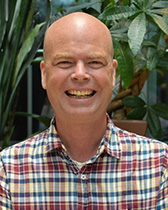Matthew Hurtgen
Professor
M.S. Geosciences, University of Missouri
B.S. Geosciences, State University of New York
B.A. Political Science, University of Rochester
Curriculum Vitae

- matt@earth.northwestern.edu
- Website
- 847-491-7539
- Tech F498/F499
Research
My research group seeks to better understand how the fundamental coupled components of the Earth system—the atmosphere, biosphere, hydrosphere, and solid Earth—interact to regulate the chemical composition of the ocean-atmosphere system and how this has changed over the past one billion years. More specifically, we focus on the complex set of processes that influence the temporal and spatial evolution of redox conditions during periods of marine anoxia, the biogeochemical feedback mechanisms that regulate the exogenic carbon cycle, and the evolution of the marine biosphere. To investigate these relationships, we study modern and ancient sedimentary systems, integrate field observations with a variety of geochemical tools, and combine these efforts with simple geochemical models.
Teaching
EARTH 102: College Seminar: The Gaia Hypothesis
EARTH 105: Climate Catastrophes in Earth History
EARTH 210: Earth Systems Science
EARTH 312: Stable Isotope Geochemistry
EARTH 390: Biogeochemical Cycles
Selected Publications
Podrecca L.G., Masterson A.L., Hurtgen M.T., Taylor J., Lloyd J.M., Selby D., Sageman B.B. (2025) Microbial sulfate reduction regulated by relative sea level change in a Pleistocene-Holocene sedimentary record: Insights from Loch Duart, Scotland, UK. Chemical Geology, v 677. https://doi.org/10.1016/j.chemgeo.2025.122633
Wang J., Jacobson A.D., Sageman B.B., Hurtgen M.T. (2023) d44/40Ca-d88/86Sr multi-proxy constrains primary origin of Marinoan cap carbonates. Geochimica et Cosmochimica Acta, v. 353, p. 13-27. doi: https://doi.org/10.1016/j.gca.2023.04.023.
Kitch G.D., Jacobson A.D., Sageman B.B., Coccioni R., Chung-Swanson T., Ankney M.E., Hurtgen M.T. (2022) Calcium isotope ratios of malformed foraminifera reveal biocalcification stress preceded Oceanic Anoxic Event 2. Nature Communications Earth and Environment, v. 3, 315. https://doi.org/10.1038/s43247-022-00641-0.
Kitch G.D., Jacobson A.D., Hurtgen M.T., Sageman B.B., Harper D.T., Zachos J.C. (2021) Calcium isotope composition of Morozovella over the Late Paleocene-Early Eocene. Geology, v. 49, p. 723-727.
Wang J.W., Jacobson A.D., Sageman B.B., Hurtgen M.T. (2021) Stable Ca and Sr isotopes support volcanically-triggered biocalcification crisis during Oceanic Anoxic Event 1a. Geology, v. 49, p. 515-519. DOI: 10.1130/G47945.1.
Joo Y.J., Sageman B.B., Hurtgen M.T. (2020) Data-model comparison reveals key environmental changes leading to Cenomanian-Turonian Oceanic Anoxic Event 2. Earth-Science Reviews, v. 203, p. 1-15.
Linzmeier B.J., Jacobson A.D., Sageman B.B., Hurtgen M.T., Ankney M.E., Petersen S.V., Tobin T.S., Kitch G.D., Wang J (2020) Calcium isotope evidence for environmental variability before and across the Cretaceous-Paleogene mass extinction. Geology, v. 48, p. 34-38.
Wang J.W., Jacobson A.D., Zhang H., Ramezani J., Sageman B.B., Hurtgen M.T., Bowring S.A., Shen, S. (2019) Coupled d44/40Ca, 87Sr/86Sr, and d88/86Sr geochemistry across the end-Permian mass extinction event. Geochimica et Cosmochimica Acta, v. 261, p. 143-165.
Kristall B., Jacobson A.D., Sageman B.B., Hurtgen M.T. (2018) Coupled strontium-sulfur cycle modeling and the Early Cretaceous sulfur isotope record. Palaeogeography, Palaeoclimatology, Palaeoecology, v. 496, p. 305-322.
Mills J.V., *Gomes M.L., *Kristall, B., Sageman B.B., Jacobson A.D., Hurtgen M.T. (2017) Massive volcanism, evaporite deposition, and the chemical evolution of the Early Cretaceous ocean. Geology, v. 45, p. 475-478. doi:10.1130/G38667.1
Kristall B., Jacobson A.D., Hurtgen M.T. (2017) Modeling the seawater radiogenic strontium isotope record: A case study of the Late Jurassic – Early Cretaceous. Palaeogeography, Palaeoclimatology, Palaeoecology, v. 472, p. 163-176.
Holmden C., Jacobson A.D., Sageman B.B., and Hurtgen M.T. (2016) Response of the Cr isotope proxy to Cretaceous Ocean Anoxic Event 2 in a pelagic carbonate succession from the Western Interior Seaway. Geochimica et Cosmochimica Acta, v. 186, p. 277-295.
Gomes M.L., Hurtgen M.T., and Sageman B.B. (2016) Biogeochemical sulfur cycling during Cretaceous Ocean Anoxic Events: A comparison of OAE1a and OAE2. Paleoceanography, v. 31, p. 233-251, doi:10.1002/2015PA002869.
Sim M.S., Ono S., Hurtgen M.T. (2015) Sulfur isotope evidence for low and fluctuating sulfate levels in the Late Devonian ocean and the potential link with the mass extinction event. Earth and Planetary Science Letters, v. 419, p. 52-62.
Gomes M.L., Hurtgen M.T. (2015) Sulfur isotope fractionation in modern euxinic systems: Implications for paleoenvironmental reconstructions of paired sulfate-sulfide isotope records. Geochimica et Cosmochimica Acta, v. 157, p. 39-55.
Du Vivier A.D.C., Jacobson A.D., Lehn G.O., Selby D., Hurtgen M.T., Sageman, B.B. (2015) Ca isotope stratigraphy across the Cenomanian-Turonian OAE2: links between volcanism, seawater geochemistry, and the carbonate fractionation factor. Earth and Planetary Science Letters, v. 416, p. 121-131.
Gomes M.L., Hurtgen M.T. (2013) Sulfur isotope systematics of a euxinic, low-sulfate lake: Evaluating the importance of the reservoir effect in modern and ancient oceans. Geology, v. 41, p. 663-666.
